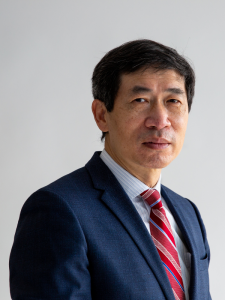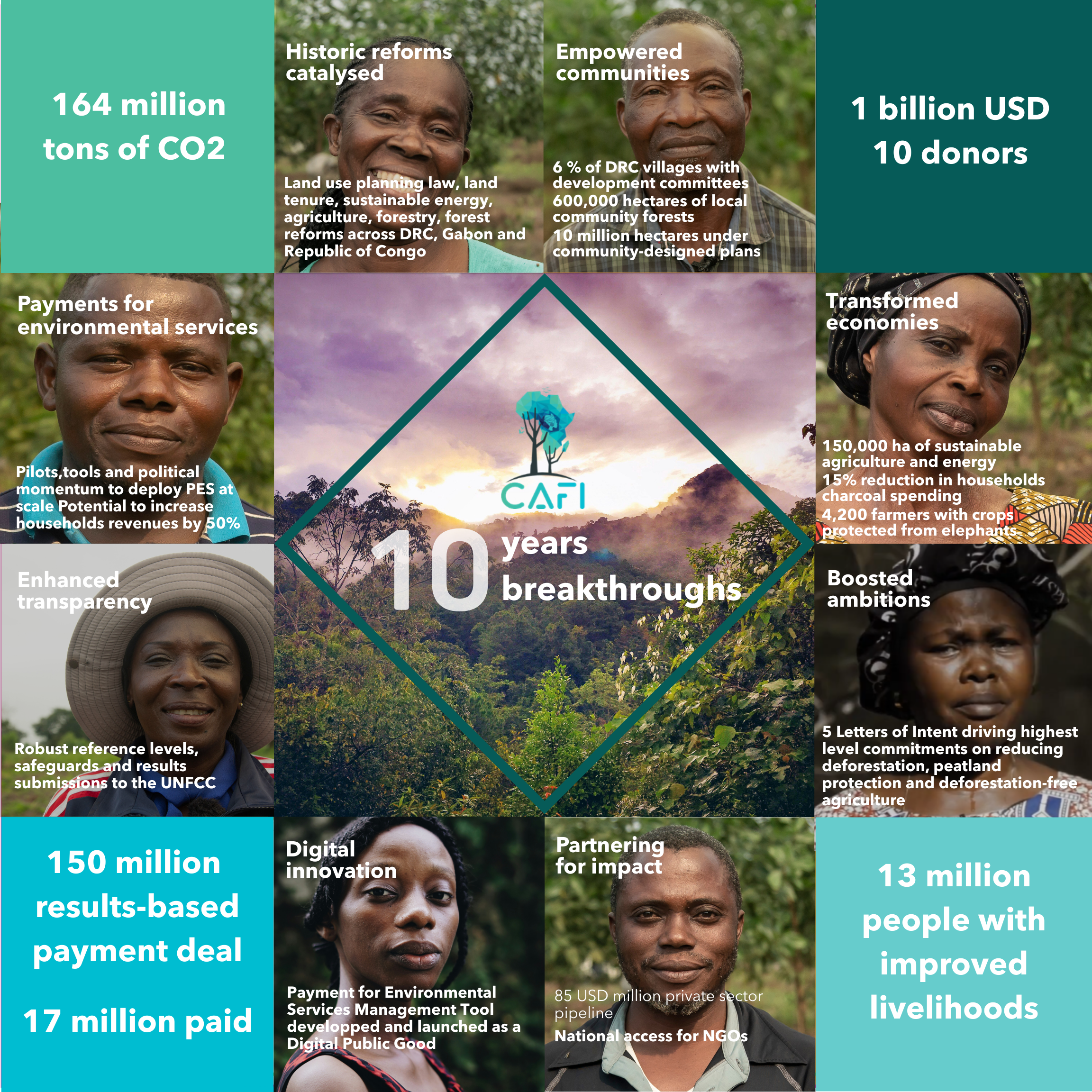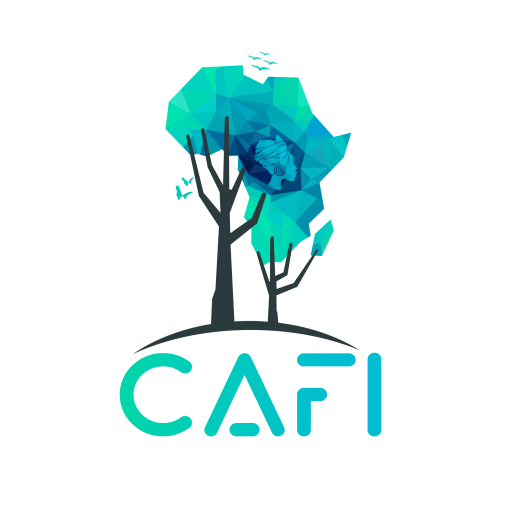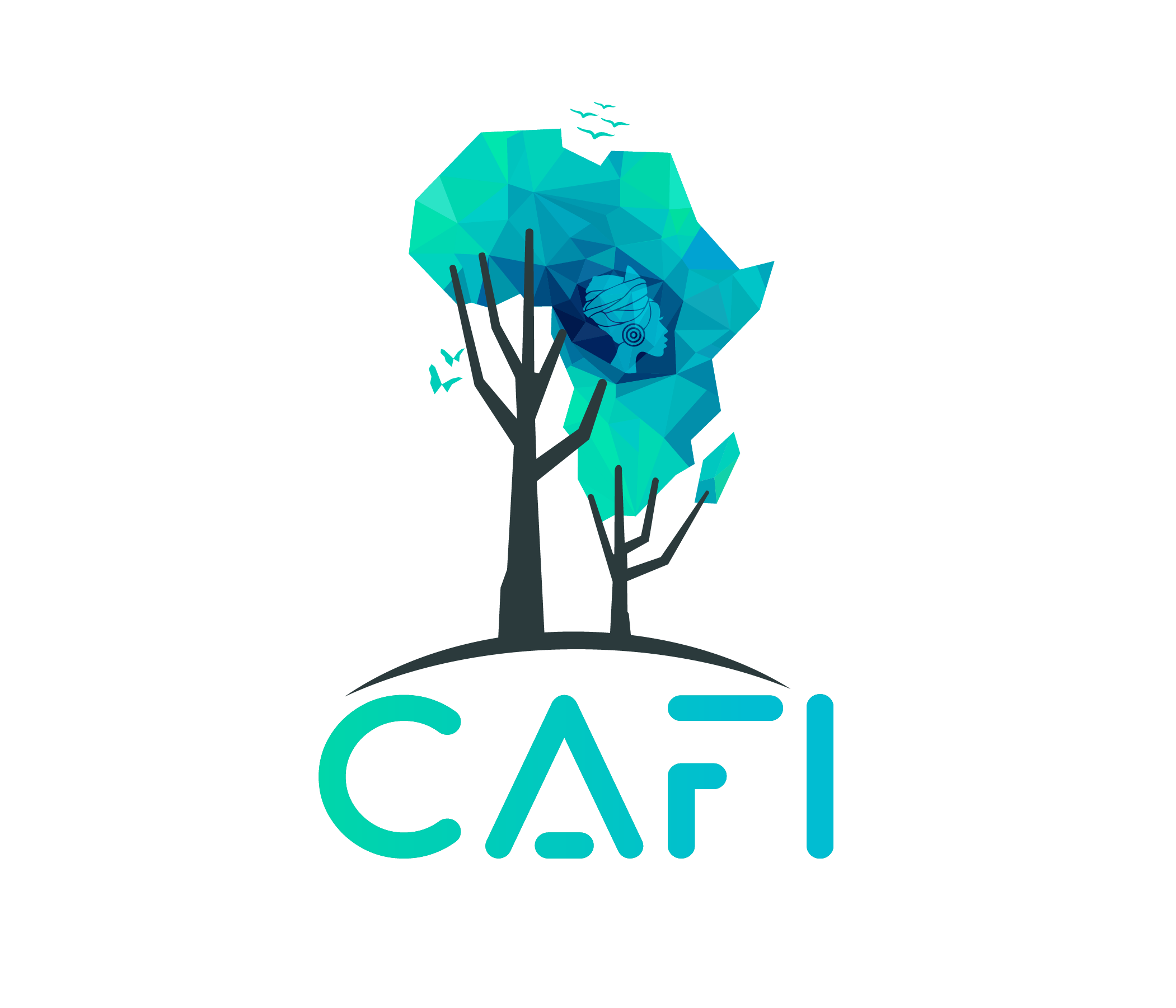CAFI was founded in 2015 during the United Nations General Assembly in New York. Ten years later, as the international community gathers once again in New York for the 80th General Assembly, CAFI proudly celebrates a decade of breakthroughs.
These milestones have been achieved against the backdrop of an exceptionally challenging decade—marked by a global pandemic, persistent conflicts, worsening impacts of climate change, and mounting pressures on natural resources. Despite these obstacles, CAFI has remained steadfast in its mission to safeguard Central Africa’s forests and improve the lives of the people who depend on them.
Over the past 10 years, CAFI has helped shape an unprecedented wave of collective action and reform, delivering concrete results on the ground.
Foreword by the DRC Minister of Environment, Sustainable Development and New Climate Economy

Professor Marie Nyange Ndambo Minister of Environment, Sustainable Development and New Climate Economy, Democratic Republic of the Congo
The Central African Forest Initiative is both the major financial instrument and the main platform for political dialogue aimed at preserving the forests of the Congo Basin. Ten years ago, the Democratic Republic of Congo (DRC) was the first country to commit to it alongside its financial partners, affirming a strong conviction: the forests of Central Africa are not only a regional asset, but also a vital and global lever in the fight against climate change and in adapting to its effects.
Over the past ten years, CAFI has become a catalyst for unprecedented reforms, placing forests at the heart of public policy. This milestone paves the way for even greater ambition: to mobilise sustainable, predictable, and equitable financing to collectively ensure the implementation of our commitments.
The DRC, together with the countries of Central Africa with whom it shares this priceless asset, is pleased to continue this partnership in a new phase, marked by the deployment of Payments for Environmental Services, which will generate visible and lasting impacts for the populations and forest ecosystems of Central Africa.
I am honoured to be part of the presentation of the results achieved over this decade, and call on all partners to join the Central African Forest Initiative.
Foreword by the UNDP Administrator

Haoliang Xu, Acting Administrator and UN Under Secretary-General, United Nations Development Programme
The United Nations Development Programme is proud to have played a foundational role in establishing the Central African Forest Initiative. As the UN Executive Board Member of the Fund and, together with our sister UN organizations (FAO, IFAD, UNCDF, UNEP, UNESCO and UNOPS), we remain a committed partner in supporting its six member countries to implement transformative, long-term reforms.
CAFI’s achievements are a testament to the leadership and dedication of the countries and communities whose efforts continue to drive progress on the ground. Since its launch in 2015, CAFI has mobilised over 1 billion dollars, funding 74 projects and transferring 631 million dollars to country and regional initiatives. These investments support the protection of Central Africa’s forests, which form the world’s largest tropical carbon sink, absorbing 1.2 billion tons of CO₂ annually—equivalent to 4% of global emissions. Yet, between 2016 and 2023, the region lost 9.6 million hectares of forest and saw 6.9 million hectares degraded, underscoring the urgency of our collective action.
The results highlighted in this report demonstrate that, even in the face of complex challenges, meaningful progress is possible. CAFI’s innovative, country-led approaches are accelerating our shared commitment to protect these forests for future generations—safeguarding biodiversity, empowering communities, and advancing climate resilience and sustainable development.
As we look ahead, the United Nations remain steadfast in its support for CAFI and its partners, working together to ensure that Central Africa’s forests continue to serve as a global public good and a foundation for inclusive, sustainable growth.
13 million people with improved livelihoods and 164 million tons of CO2 emission reductions
Since 2015, CAFI has shown that protecting forests can go hand in hand with improving lives. By the end of 2024, its programs have reached around 13 million people across Central Africa—urban households, smallholder farmers, women and girls.
Most remarkably, these livelihoods were improved while funding 164 million tons of CO₂ emission reductions, the equivalent of energy usage of 20 million households in Western Europe – proof that human development and reduced poverty can be decoupled from CO2 emissions.
In the Democratic Republic of Congo, more than 163,000 families in major cities now cook with improved stoves or LPG, saving money each month and breathing cleaner air at home. In rural areas, families who once farmed without secure tenure now hold titles to community forests. For the first time, over a million people have the right to decide how their land is used and to benefit from it sustainably—whether through selling non-timber products, managing timber responsibly, or developing ecotourism.
Farmers are at the centre of change. CAFI-supported programs have introduced zero-deforestation farming on tens of thousands of hectares, helping families produce more nutritious food and cash crops without clearing new forest. In Cameroon, a new program is guiding 350,000 cocoa and coffee producers toward markets that reward deforestation-free production, opening up future opportunities for rural families.
Women and girls are also key beneficiaries. More than 3 million people have accessed reproductive health and family planning services, with close to half a million women choosing long-acting contraceptive methods. These services give families greater control over their future.
Together, these examples illustrate how CAFI’s holistic approach has improved millions of lives while delivering measurable climate benefits.
Lessons learned
CAFI’s experience proves that when people thrive, forests thrive too. By helping families save money on cooking fuel, supporting farmers to grow more without cutting trees, securing community land rights, and enabling women to plan their futures, CAFI has created conditions where protecting forests is also the path to prosperity. The lesson is that climate action cannot succeed in isolation from people’s needs. CAFI’s holistic approach—linking services, rights, and opportunities—shows that human development and forest conservation are mutually reinforcing.
1 billion dollars and 10 donors mobilised for Central Africa’s forests and people
CAFI was created in 2015 to bridge the funding gap for Central African forests as a dedicated instrument aiming to mobilise 500 million USD.
Today, CAFI has doubled this figure.
From 1 contributor and $9 million USD in 2015 to 972 million committed by 10 donors, CAFI’s journey in successfully mobilising donors and funding commitments has underscored the importance of transparency, strategic agility, donors alignment, and adaptive management.
Fostering a culture of consensus and peer-exchange within the Executive Board. combined with agile decision-making and strong leadership in navigating volatile environments, has helped CAFI donors sustain confidence over time.
In addition to legally required annual reports, providing monthly briefing notes to the Executive Board and offering online tools – such as the MPTF Gateway for financial information and the CAFI Metrics Hub for results – allows contributors to remain informed and engaged.
Finally, fostering high level policy dialogue – between Ambassadors and Ministers in the sub-region has proven key to create a joint vision and sustain mutual confidence.
Lesson learned
Implementing CAFI’s whole-of-government approach, i.e. engaging all sectors in a constructive dialogue on the optimal use of resources, requires commensurate funding and long-term financial commitments. In a virtuous loop, CAFI and its partner countries have been able to enshrine policy commitments in Letters of intent thanks to the level of resources mobilised.
Striking ambitious deals with 4 countries representing 200 million hectares of forests
CAFI’s model rests on long-term, high-ambition partnerships with forest nations. Over the past decade, four countries—Democratic Republic of Congo, Gabon, Republic of Congo, and Cameroon—have concluded formal Letters of Intent (LoI), covering a combined 200 million hectares of forests and worth over 900 million dollars.
The DRC’s 2021–2031 Letter of Intent anchors reforms in agriculture, energy, tenure, and transparency, and is now directly linked to the International Monetary Fund RSF/Extended Credit Facilty program—making forest governance a matter of macroeconomic stability. The 2019 Letter of Intent with the Republic of Congo elevated forest protection under the Prime Minister’s Office. Gabon’s letter of Intent underpinned the continent’s first large-scale Results-Based Payment agreement, that lasted despite political transition, showing resilience under changing contexts.
In Cameroon, the landmark Letter of Intent signed in October 2024 set a vision for deforestation-free agriculture by 2035, committing to raise 1.5 billion dollars and backed by $61 million in CAFI initial support for 2023–2027. Its first portfolio of projects aim to transition 350,000 cocoa and coffee producers to deforestation-free production, implementing PES at landscape level while ensuring strong land governance structures.
These Letters of Intent are more than funding agreements: they are political compacts that link millions in potential investment to concrete reforms, milestones, and measurable results. They show that entire forest nations can pivot development strategies towards sustainability when backed by long-term trust, finance, and robust monitoring.
Lessons learned
From the inaugural Letter of Intent with DRC in 2016 to the 2024 Cameroon LoI, letters of Intent have differed with lessons learned and the diversity of country partners. What has remained a constant is the fact that high-ambition compacts succeed when they are country-owned, milestone-based, and anchored in high-level politics and leadership. Integrating forest milestones into IMF and World Bank programs gave them fiscal and macroeconomic weight. Annual joint reviews have kept parties accountable and allowed course corrections. Most remarkable, LoIs have proven resilient through political cycles—ensuring that reforms and investments remain on track even amid government transitions.
Pioneering Results-Based Finance
Gabon’s partnership with CAFI delivered Africa’s first large-scale Results-Based Payment (RBP) agreement. Signed in 2019, the Agreement, as an avenant to the 2017 letter of Intent, pledged $150 million for demonstrated CO₂ emission reductions, turning forest protection into a performance-based reward. Gabon quickly demonstrated results: the first $17 million tranche was paid in 2020, in turn funding five projects to channel proceeds into protected areas expansion and management, community forestry, governance, monitoring, youth environmental education and greener cities.
This agreement marked a first of its kind in Africa, showing that national-level emission reductions can be credibly measured, independently verified, and rewarded through performance-based finance. It also created a financial loop: verified results translated into investments in the very institutions and programs that sustain conservation. By doing so, the mechanism ensured that forests not only remained standing but also contributed to economic and social resilience. The agreement has proven resilient. Despite Gabon’s political transition in 2023, the RBP arrangement has held firm, reflecting the robustness of the model and the shared commitment of all parties.
Today, the Gabonese RBP serves as an important reference point for the region. It has influenced CAFI’s broader shift toward performance-based approaches backed by third party verifications. It demonstrated that results-based finance is not theoretical in Africa—it can work effectively to support both national systems and local solutions.
Lessons learned
For Results-based Payments to succeed, three conditions are essential: credible national monitoring and reporting systems, clear payout pathways, and institutional resilience. Gabon’s experience showed the value of beginning with smaller tranches to test the system, then reinvesting proceeds into institutions and programs that generate lasting reductions. Therefore RBPs should be seen not as an end point but as a foundation—one that can catalyse reforms, nourish Payments for Environmental Services approaches, and attract private finance, creating a performance-based ecosystem that rewards forest protection at multiple levels.
Catalysing 6 transformative reforms
A potential to shape, for decades to come, how land and natural resources are used while protecting forests.
From the outset, CAFI recognised that durable forest protection requires systemic change.
In the Democratic Republic of Congo, six key reforms have advanced in ways that will shape how land and resources are managed for decades. A Land-Use Planning Law, resulting from a project initiated at CAFI’s onset in 2016, was promulgated by the DRC President in July 2025, and provides the legal framework to allocate land for farming, forestry, mining, conservation, and settlement in a transparent and coordinated way. The development of regulatory texts was supported to promptly put the law into action. The National Agriculture Policy, adopted in February 2023, directs crop expansion toward savannahs and degraded lands, while embedding safeguards for intact forests and peatlands. The Land Tenure Policy, endorsed in April 2022, laid the foundation for a new law and digital information system, while piloting provincial commissions that address customary and statutory rights, safeguard Indigenous Peoples, and advance gender equity.
In the energy sector, the National Sustainable Energy Policy was validated in December 2022, and complemented soon after by a strategic environmental and social assessment, a next step toward adoption. This policy paves the way for a large-scale transition to Liquid Gas Petroleum and cleaner cooking fuels. With regard to the forest sector, a National Consultative Council on Forests was established in 2023, providing an institutional space for participation, accountability, and guidance on forest reforms.
Support to reform is not limited to the DRC. In Gabon, CAFI has supported reforms on agricultural land tenure, with a first draft land-use optimisation, and conflict-sensitive governance. And in the Republic of Congo, large-scale reform and investments in land use planning are underway.
Lessons learned
CAFI’s support to reform processes has shown that progress happens when technical preparation is matched with political will. Facilitating dialogue between ministries, building analytical foundations, and funding early institutional capacity were all essential to move policies from draft to adoption. The lesson is that systemic change requires both top-down frameworks and bottom-up pilots. By supporting this dual approach, CAFI has helped turn national commitments into durable structures that protect forests and enable sustainable use of land and natural resources.
Delivering lasting results that transform rural communities
Across Central Africa, CAFI has enabled rural communities to improve their livelihoods while protecting the forests they depend on. The most visible impacts are found where people live and farm. Over 10 years, community- developed local land-use plans in the DRC, covering close to 10 million hectares have been validated, giving thousands of villages a say in how land is farmed, restored, or conserved. Through local development committees, now established in six per cent of DRC villages and in which women often hold more than a third of seats, forest protection and sustainable management of natural resources is rooted in inclusive, community-driven decision-making.
Farmers are reporting tangible benefits. More than 72,000 hectares of sustainable agriculture have been established, practically demonstrating how higher yields, diversified crops and enhanced revenues can be achieved without clearing new land. CAFI funding has allowed the expansion of community forestry concessions to an additional 600,000 hectares, representing 15% of granted local community forest concessions in the DRC and giving secure rights and new opportunities to more than a million people. These titles transform communities from forest users into stewards with legal authority and potential revenue streams.
Energy transitions have also changed daily life. Over 160,000 households in major cities now cook with improved stoves or liquid gas petroleum, reducing their fuel costs by up to 15 percent and cutting charcoal use by as much as 8 percent. On the supply side, more than 60,000 hectares of plantations and natural regeneration provide sustainable wood energy, creating jobs while lowering pressure on natural forests.
In Gabon, the swift installation of electric fences in just a few months is already shielding 4,200 farmers from elephant raids, protecting crops and livelihoods.
Together, these achievements demonstrate CAFI’s impact towards fuller harvests, stronger rights, lower household costs, and safer, more sustainable futures for millions of rural and urban populations
Lessons learned
CAFI’s experience demonstrates that rural communities protect forests when their basic needs and aspirations are addressed. Secure rights, higher yields, clean energy, and protection from risks like crop loss make sustainable choices practical and profitable. Quick, visible improvements—such as energy savings or safer fields—build trust, while deeper shifts in farming and land governance ensure long-term change. The lesson is that only by combining these elements can households see forest-friendly development as the most rational and rewarding path. CAFI’s integrated approach has proven that better livelihoods and forest conservation go hand in hand.
Laying the Foundation for Payments for Environmental Services
CAFI had taken decisive steps to move Payments for Environmental Services (PES) from concept to practice in Central Africa.
In 2024, a regional PES framework was finalised, setting out six eligible activities—including agroforestry, community forestry, natural regeneration, conservation — together with templates for contracts, monitoring, and verification. To support implementation, CAFI launched two digital platforms: Ground Impact, which enables ex-ante planning and modelling, and the PES Management Tool, a digital public good that ensures efficient management, from registering and contracting the beneficiaries, or environmental services providers, to making mobile payments based on validated results.
CAFI’s current PES framework and tools, or PES 2.0, are the result of a decade of experimentation in the region. Pilot activities, integrated into rural development projects since 2016 in 9 DRC provinces, have tested different approaches to compensate farmers and communities for forest-friendly practices. These early experiences demonstrated strong local interest but also exposed challenges: cash transfers without formal contracts, complex and lengthy procedures, limited georeferencing and verification, and high costs due to multiple intermediaries. Far from setbacks, these lessons informed the design of the more robust, scalable, second generation of PES.
Now pilots, in line with this 2.0 approach and tools, are under way, with some expected to generate payments by the UNFCCC CoP in Belem. In the Plateaux district and the Kongo Central of the DRC, communities are expected to receive annual payments for validated results in agroforestry (combining sustainable fuelwood production with subsistence agriculture) and in perennial crops (palm oil plantations in savannahs) worth $600,000, covering 95,000 hectares and benefitting about 20,000. In the Republic of Congo, agroforestry plantations are underway on lands formally allocated by the Government.
In 2025, CAFI and Governments launched PES programming around DRC’s Kinshasa supply chain and the Central African Republic’s Bangui area. Testing a combination of “production” and “conservation” PES, contextualising tools in various countries and landscape, these programmes will generate evidence to inform the expansion of land management portfolios.
Momentum is also building at the political level. An interministerial PES conference in January 2025, hosted in the DRC with CAFI support, gathered governments to agree on roadmaps for scaling PES. In parallel, a South–South partnership with Costa Rica—a global pioneer in PES—offers valuable knowledge-sharing for adapting successful approaches to Central Africa’s context. While still at an early stage, PES represents a profound shift: from financing activities to financing verified results, linking communities and households to the architecture of climate finance.
Lessons learned
Early PES pilots confirmed that communities are eager to be rewarded for sustainable practices, while highlighting the practical obstacles that can undermine trust. CAFI used these lessons to standardise eligible activities, develop digital platforms, and simplify contracts, making payments clearer, faster, and more transparent. PES have always been viable, but needed refinement to become efficient and scalable. By learning iteratively—from initial PIREDD pilots over the past decade to current “PES 2.0” projects, CAFI and its partners are uniquely positioned to reward households and communities for protecting forests in a manner that is fair, cost-efficient and trustworthy.
Unlocking New Partnerships with the private sector
Public finance alone cannot shift the economic pressures driving deforestation. The private sector plays a decisive role in agriculture, forestry, and energy, and engaging it is therefore essential to transform value chains and scale up sustainable practices. In 2024, CAFI advanced this agenda by developing concrete partnerships and tools that channel private capital into forest-positive investments under strict environmental and social safeguards.
A key step was the launch of CAFI’s Private Sector Investment Facility, a USD 100 million envelope designed to de-risk investments and mobilise significant co-financing for deforestation-free growth. As part of its inception, CAFI financed a suite of feasibility studies with companies including INTERHOLCO, ARISE, Mushiete & Co, GoCongo, and Criterion Africa Partners. These studies generate the business cases, risk analyses, and financial structures needed to convert promising ideas into bankable deals—laying the groundwork for a robust pipeline of sustainable investments.
Remarkably, CAFI signed a USD 51 million partnership with the &Green Fund. The fund invests in commodities with high deforestation risks—livestock, palm oil, rubber, cocoa, soy, and plantation forestry—under rigorous “No Deforestation, No Peat, No Exploitation” standards and jurisdictional eligibility criteria. This single partnership is expected to leverage $96 million in private capital, creating a total investment impact close to $147 million.
To prepare the next wave of investable projects, CAFI approved two preparatory grants in 2024: one to IDH for “ReVive Central Africa” on deforestation-free cocoa and coffee supply chains and another to the Common Fund for Commodities (CFC) , aiming to provide financing solutions for small and medium enterprises in agriculture and forestry.
Together, these actions demonstrate CAFI’s innovative approach: setting clear safeguards, testing markets, and creating confidence so that private capital becomes a partner—rather than a threat—to Central Africa’s forests and communities.
Lessons learned
Private investment requires more than capital—it requires confidence. CAFI has learned that credibility comes from jurisdictional eligibility rules, transparent monitoring, and enforceable safeguards. Technical assistance and preparatory grants are indispensable for moving from promising ideas to bankable deals. Partnerships like &Green show that public funding can leverage significant private capital when risks are reduced and standards are clear. The lesson: CAFI’s role is catalytic, not permanent. By structuring pipelines, de-risking investments, and embedding performance rules, CAFI ensures that private actors can scale forest-positive models while aligning with national Letters of Intent.
Strengthening forest monitoring for better governance and UNFCCC reporting
CAFI has helped establish national systems that are credible, transparent, and used for decision-making.
In the Republic of Congo, the national forest monitoring system allowed the submission of the country’s National Reference Emission Level are operational, with a web-based interface providing open access to deforestation data. An inventory of 580+ permits and concessions across sectors now improves transparency and enforcement.
In the DRC, the CAFI- supported National Forest Monitoring System underpinned ambition setting and reporting to the UNFCCC. The National Consultative Council on Forests, created in 2023, steers updates to data and reporting, while CAFI’s portfolio uses independent, sample-based satellite verification introduced in 2024. These checks validate project-level results, from agroforestry plots to clean-cooking adoption, and will soon be automated through an AI/cloud-based remote sensing platform.
In Gabon, CAFI support has catalysed the submission of the Summary of information on safeguards, reference level and results reporting to the UNFCCC, accompanying monitoring capacities that sustain the country’s RBP agreement, including satellite analysis and biodiversity and forest inventories.
Regionally, a CAFI-funded FAO study has delivered annual, harmonised, nationally accepted estimates of deforestation and degradation and the driver that underpin them, creating a common evidence base for policy and finance.
Lessons learned
Forest monitoring works when it is nationally owned, publicly accessible, and tied to consequences. CAFI learned that open portals and regular UNFCCC submissions build trust, while independent satellite verification strengthens credibility for performance finance. Linking MRV to policy ensures monitoring informs real decisions. Investment in MRV must continue to allow for comparability and transparency.
Opening up the Fund to national Access for NGOs
Initially, CAFI funds solely flowed through UN and International Cooperation Agencies. Progressively, CAFI required disclosure of all sub-contracts above $100,000, thus tracking the share of funding that reaches national NGOs, administrations, and businesses. Yet, while limiting the diversity of implementing organizations fostered needed confidence at the Fund on-start, it also raised questions of national ownership and limited options when facing slow delivery. Responding to lessons and demands from partners, CAFI opened access to international NGOs and, in 2025, opened up the CAFI Fund access to national NGOs.
To make this shift workable, CAFI established a Regional Technical Assistance Facility, implemented by UNOPS, to help national institutions and civil society organisations meet international standards for fiduciary integrity, safeguards, and monitoring. This facility provides tailored support—from financial management coaching to environmental and social safeguard training—so that capable national actors can qualify for direct funding.
24 implementing organisations now have access to CAFI, with NGOs and investment funds representing the fastest growing share of approved grants. This diversification strengthens delivery options, reduces reliance on a small group of intermediaries, and embeds CAFI’s work more firmly within national contexts.
These changes are not only procedural—they represent a shift in CAFI’s approach, towards a platform where local actors can lead implementation while meeting international standards for fiduciary integrity, safeguards, and monitoring. Over the next decade, direct local access will be the benchmark of ownership and sustainability.
Lessons learned
Expanding access requires both rigour and support. Access criteria must remain strict, but pathways to meet them must be funded—through readiness grants, managing-agent support, and capacity-building. Transparency is vital: publishing large sub-contracts and results data builds trust in delivery at the local level. CAFI has learned that diversification of implementers increases resilience and innovation, but only if reporting quality and safeguards keep pace. The lesson: open the door gradually, build capacity, and insist on accountability. True sustainability comes when local NGOs and institutions are not just implementers but stewards of long-term forest protection finance.
Looking Ahead
As CAFI enters its second decade, the coalition is building on this strong foundation to scale up ambition and impact. The stakes have never been higher: Central Africa’s forests are not only vital for regional development and resilience but also for the stability of the global climate.
Together with its partners, CAFI will continue to champion innovative, inclusive, and results-driven solutions—so that Central Africa’s forests, people, and planet can thrive for generations to come.



 CAFI-10-Years-10-Breakthroughs-2025.pdf
CAFI-10-Years-10-Breakthroughs-2025.pdf